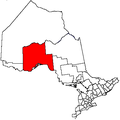Lake Nipigon Indian Reserve Animbiigoo Zaagi'igan Anishinaabek | |
|---|---|
| Coordinates: 49°43′N87°23′W / 49.717°N 87.383°W | |
| Country | |
| Province | |
| District | Thunder Bay |
| First Nation | Animbiigoo Zaagi'igan Anishinaabek |
| Area | |
| • Land | 12.699 km2 (4.903 sq mi) |
| Population (2023) [2] | |
• Total | 482 |
| Website | www.aza.ca |
Animbiigoo Zaagi'igan Anishinaabek First Nation is an Ojibwe First Nation in northwestern Ontario. It has a reserve on Partridge Lake called Lake Nipigon Indian Reserve within the town of Greenstone. It is a member of Waaskiinaysay Ziibi Inc.

